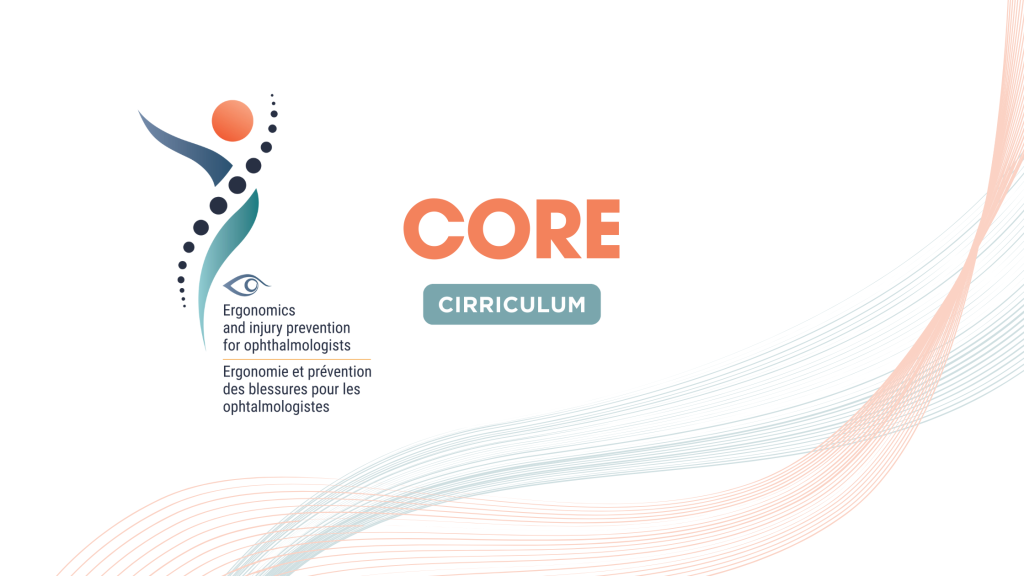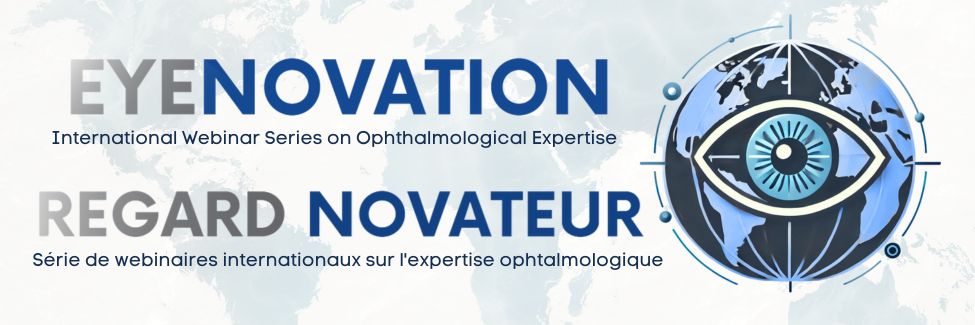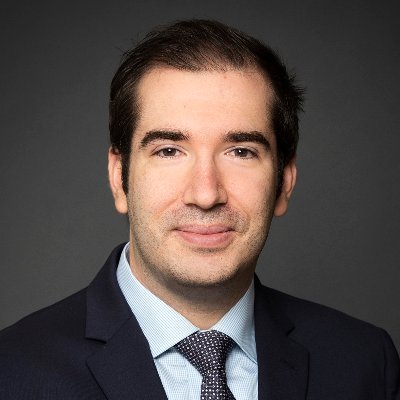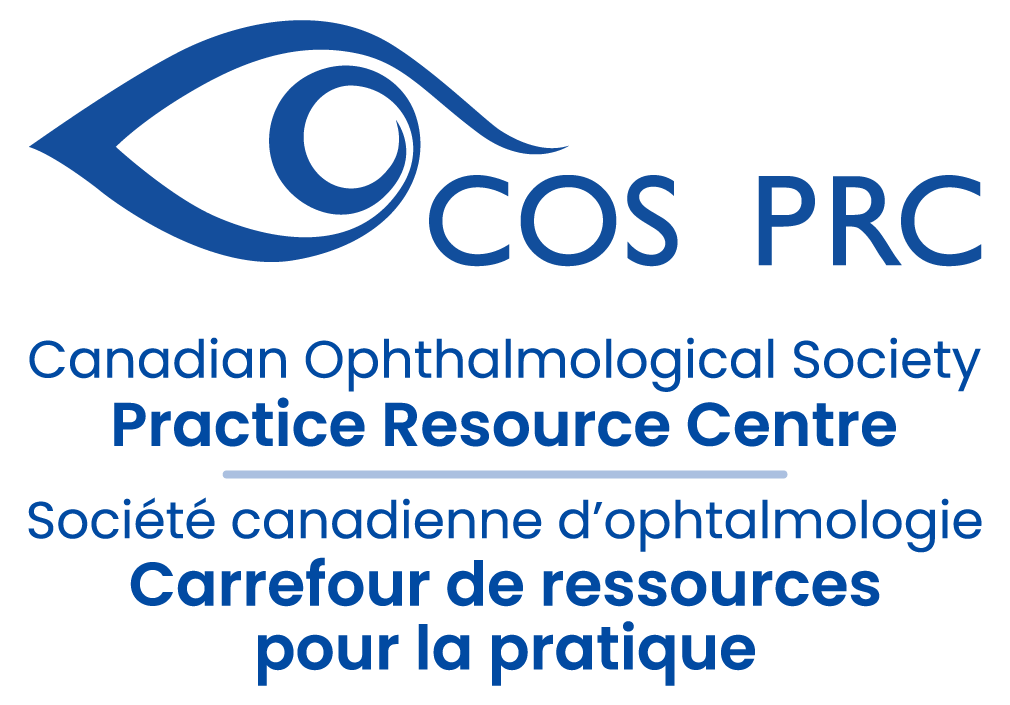2025-2026 CORE Curriculum

On behalf of the COS Ergonomics and Injury Prevention Working Group and the Committee on Ophthalmology Residents Ergonomics Education, we are pleased to share with you the 2025–26 CORE Curriculum.
The attached CORE Curriculum Guide outlines six practical and easy-to-implement initiatives designed to promote ergonomic awareness and injury prevention among the residents in your program.
As October marks National Ergonomics Awareness Month, we encourage you to initiate the curriculum during this time. Should you have any questions, please feel free to reach out to any member of the CORE team. We appreciate your support in fostering resident wellbeing and a healthier ophthalmology workforce.
Warm regards,
CORE members:
Dr. Harald Gjerde
Dr. R. Rishi Gupta
Dr. Femida Kherani
Dr. Rookaya Mather
Guidelines for Supply Triage During Visudyne (Verteporfin) Shortage

Created on July 16, 2021
Revised September 19, 2025
Visudyne is an essential therapeutic agent for the treatment of specific sight-threatening
retinal and choroidal diseases, including choroidal tumours, anti-VEGF resistant neovascular
age-related macular degeneration (nAMD) and central serous choroidopathy (CSC). There is
an active global shortage of Visudyne, and the next resupply is not expected to be available in
Canada until the end of June 2026 (see: www.drugshortagescanada.ca).
The Canadian Retina Society (CRS) and Canadian Ophthalmological Society (COS) are working
with Health Canada’s Drug Shortages Unit on this issue. Further, the CRS and the COS are
suggesting the following mitigation strategies and suggest that the remaining supply of
Visudyne be prioritized as follows:
- Priority 1: For the full course of treatment and management of sight threatening Ocular Tumours
- Priority 2: For the treatment of non-resolving CSC
- Priority 3: For the treatment of anti-VEGF resistant nAMD
The CRS and COS provide this information for guidance and urge all treating Ophthalmologists
to collaborate with their local and regional oncology and retinal specialist groups to ensure
careful triage of this agent to those patients in most dire need.
DOVS RESIDENT TEACHING – Eyelids – IN PERSON
Date: Friday September 26
Time: 8:45 AM – 12:00 PM
Location: 45 Brunswick Ave., Multipurpose Room B, Toronto
Title: Eyelids
Speakers: Dr. Nancy Tucker
The VPP Grand Rounds Local and Visiting Professor Program is a self-approved group learning activity (Section 1) as defined by the Maintenance of Certification program of The Royal College of Physicians and Surgeons of Canada.
EyeNovation Webinar: Inherited Retinal Disorders: Progress, Promise, and Lessons Beyond Setbacks – Recording

Did you miss the webinar? Not to worry, a recording is available below!
Inherited Retinal Disorders: Progress, Promise, and Lessons Beyond Setbacks
Presented by Dr. Ioannis Dimopoulos, MD, MSc, FRCSC
Join us for an in-depth session as Dr. Dimopoulos explores the latest advancements in inherited retinal disease (IRD) research, emerging therapeutic approaches, and key lessons learned from clinical challenges.

Dr. Dimopoulos obtained his medical degree from the University of Athens and subsequently completed graduate studies and a research fellowship in Ocular Genetics at the University of Alberta. He was directly involved and lead the outcome measure assessment for an ocular gene therapy trial for choroideremia – the first in Canada. Following his ophthalmology residency training at the University of Ottawa, he completed a 2 -year fellowship in Medical Retina & Ophthalmic Genetics at the National Eye Institute / National Institutes of Health. He recently joined the University of Ottawa’s Department of Ophthalmology as an Assistant Professor. His clinical and research interests include inherited retinal disorders, gene therapy, AMD, CSCR, and diabetic retinopathy.
Learning Objectives:
By the end of the session, participants will be able to:
- Describe the genetic and clinical landscape of inherited retinal disorders (IRDs) and the associated unmet medical needs
- Explain the principles, current applications, and clinical progress of gene therapy in retinal diseases, including the case of choroideremia
- Discuss future directions, challenges, and emerging technologies in the development of gene therapy for IRDs.
Ergonomics: Other Ergonomics Resources for Physicians
2025-2026 CORE Cirriculum
Description: CORE Curriculum Guide outlines six practical and easy-to-implement initiatives designed to promote ergonomic awareness and injury prevention among the residents in your program
Link: https://www.cosprc.ca/2025-2026-core-curriculum/
Dalhousie University – EH&S Ergonomics Program
Description: Dalhousie’s Environmental Health & Safety Office offers ergonomic assessments and training for faculty and staff. Their educational video series, featuring the Dal Tiger, demonstrates proper office chair and workstation setup to reduce strain and prevent injury.
Link: http://www.dal.ca/dept/safety/programs-services/occupational-safety/ergonomics.html
Correct Sitting Posture: Office – Physio Med
Description: This highly visual guide offers practical, illustrated advice on optimal sitting posture for desk-based workers. Developed by Physio Med, it explains how poor posture contributes to back, neck, and metabolic problems, and emphasizes the 20/20 rule (move every 20 minutes for 20 seconds). Key topics include chair and desk setup, pelvic tilt, spine alignment, and use of ergonomic seating (e.g., saddle or kneeling chairs).
Link: https://www.physiomed.co.uk/uploads/guide/file/20/Physiomed_Sitting_Guide_-_Correct_Sitting_Posture_Digital.pdf
Ergonomic Principles with Cabinets in Healthcare Settings – Mid Mark
Description: Midmark explains how the design and layout of medical cabinetry can significantly impact clinician workflow, efficiency, and physical well-being. It emphasizes reducing repetitive reaching, bending, and awkward postures by aligning storage and tools within easy reach and using adjustable components. Thoughtful cabinetry design not only improves ergonomics but also enhances staff productivity and patient care quality.
Link: https://www.midmark.com/docs/default-source/resource-library/medical/whitepapers/007-10422-00-hcd-cabinetry-ergonomics-white-paper-final.pdf?sfvrsn=9067761c_1
Office Ergonomics e-Course – Government of Canada (Canadian Centre for Occupational Health and Safety)
Description: The Office Ergonomics course from the Canadian Centre for Occupational Health and Safety (CCOHS) is designed to help office workers create safer, more comfortable, and more efficient workspaces. It covers topics like proper workstation setup, posture, equipment use, and strategies to prevent musculoskeletal injuries. The course is ideal for employees, supervisors, and health and safety professionals looking to improve ergonomics in an office setting. It costs $48.00 CAD.
Link: https://www.ccohs.ca/products/courses/office_ergonomics
Office Ergonomics Fact Sheets – Government of Canada (Canadian Centre for Occupational Health and Safety)
Description: The CCOHS presents multiple digestible fact sheets summarizing key concepts in ergonomics at work including keyboard selection, computer monitor modifications, positioning, etc. An excellent resource for the individual working with electronic systems to consider prior to purchase or for maintenance.
Link: https://www.ccohs.ca/oshanswers/ergonomics/office
ErgoConsulting
Description: A Canadian company that performs ergonomic assessments and consulting at work-place settings. They are composed of a team of occupational therapists, engineers, kinesiologists and Canadian Certified Professional Ergonomists.
Link: https://ergoconsulting.ca/about-ergo-consulting/ergo-consultants/
Ergonomics Related Hazards at the Computer Workstation – Government of Canada
Description: This Canadian government guide on computer ergonomics outlines how to set up a safe and efficient computer workstation to reduce the risk of strain and injury. It covers best practices for posture, monitor and keyboard placement, lighting, and regular movement. The guide is intended for both employers and employees to help create healthier, more comfortable computer-based work environments.
Link: https://www.canada.ca/content/dam/canada/employment-social-development/migration/documents/assets/portfolio/docs/en/reports/health_safety/computer_ergonomics.pdf
Keep An Eye On Ergonomics – COS
Description: Download and print this handy poster to keep good posture top of mind. Featuring clear visuals, it covers optimal instrument gripping, chair height, and posture tips to help reduce strain and improve comfort during procedures. Perfect for displaying in your clinic or workspace!
Surgical Ergonomics Recommendations – American College of Surgeons
Description: The Surgical Ergonomics Recommendations by the American College of Surgeons outlines key strategies to reduce work-related musculoskeletal disorders among surgeons. It emphasizes optimizing operating room setup, including table height, monitor positioning, and instrument design to support neutral posture and reduce fatigue. The document also encourages incorporating ergonomic training, microbreaks, and physical conditioning into surgical practice. These recommendations aim to improve surgeon health, performance, and career longevity. Fun fact – they have an awesome title page photo.
Link: https://www.facs.org/media/tdeemrnw/23_ed_surgicalergonomicsrecommendations_pdf_v4.pdf
Ergonomics: Ophthalmology Educational Series
Title: COS Ergonomics for the Ophthalmologist Videos
Description: Explore presentations, handouts, and video recordings from the 2017 COS Annual Meeting focused on preventing musculoskeletal injury in ophthalmology. Topics include body mechanics, the prevalence of MSK disorders, and the development of ergonomic education modules. This resource features insights from clinicians and experts including Drs. Brissette, Diaconita, Ratzlaff, and Kherani, and certified athletic therapist George Matos.
Link: https://www.cosprc.ca/ergonomics-for-the-ophthalmologist/
Queen’s University – Musculoskeletal Disorders in Ophthalmologists
Description: A 30-minute online module on musculoskeletal disorders in ophthalmologists, offered by Queen’s University Department of Ophthalmology. Completion is eligible for 0.5 hours of Royal College Section 2: Self-Learning credits. Topics include ergonomic risk factors, injury prevention strategies, and posture optimization for clinical and surgical settings.
Link: https://ophthalmology.queensu.ca/academics/cme/ergonomics
Ergonomics: Podcasts & Videos
Ergonomics for Ophthalmologists at Home and in Practice
Podcast: Audio Digest
Release Date: September 21, 2024
Duration: 31 min 34 sec
Episode Description: In this episode, Dr. Martin Wand explores practical ergonomic strategies for ophthalmologists, emphasizing proper posture in both clinical and surgical settings, and highlighting the health risks of prolonged sitting.
Link: https://www.audio-digest.org/Courses/Ergonomics-for-Ophthalmologists-at-Home-and-in-Practice/3594
Video: ASCRS 2020 – Ergonomics in the Ophthalmic Practice and the ORTitle: 25. Ergonomics in Ophthalmology (Dr. R. Rishi Gupta)
Podcast: Blind Spot – The Eye Doctor’s Podcast
Release Date: June 3, 2024
Duration: 33 min 59 sec
Episode Description: The incidence of musculoskeletal injuries in ophthalmology is probably higher than you think. Whether it’s an acute injury or a chronic injury from poor posture and positioning, ophthalmologists and optometrists are at high risk for long-term back pain and other musculoskeletal problems, due to the nature of our work. So how can we do better at keeping ourselves healthy, both in the short-term and in the long run? Dr. R. Rishi Gupta joins the podcast.
Link: https://www.blindspot-podcast.com/
Hot Topics in Surgery: Ergonomics
Podcast: Behind the Knife
Release Date: September 30, 2019
Duration: 48 min 15 sec
Episode Description: Dr. Scott Hollenbeck (Duke plastic surgeon) and Marissa Pentico (occupational therapist and ergonomist) discuss practical ergonomic interventions developed through a Duke-led initiative. Learn how to prevent musculoskeletal injuries and extend your surgical career with strategies that can be integrated into everyday practice..
Link: https://behindtheknife.org/podcast/hot-topics-in-surgery-ergonomics
CRS Virtual Education: Ergonomics
Link: https://www.youtube.com/watch?v=3_9wMD062aM
Video: University of California Irvine: Igniting Passion and Safety Through Ergonomics in Ophthalmology
Duration: 58 min 17 sec
Lecturers: Dr. Donny Suh, Ophthalmologist, University of California Irvine’s Gavin Herbert Eye Institute, USA Dr. Susan Ksiazek, Ophthalmologist, Marshfield Clinic, USA Dr. Benjamin Young, Ophthalmologist, Oregon Health Sciences University, USA
Link: https://www.youtube.com/watch?v=ghb05PiZfs4&ab_channel=Cybersight
Video: ASCRS 2020 – Ergonomics in the Ophthalmic Practice and the OR
Duration: 11 min 40 sec
Lecturer: Dr. Michael E. Snyder, Ophthalmologist, University of Cincinnati, USA
Link: https://www.youtube.com/watch?v=AnFf_U2Co1o&ab_channel=Haag-StreitUSA
Podcast/video: Doc2Doc – Ergonomics in Ophthalmology
Duration: 11 min 03 sec
Lecturers: Dr. Alison Early and Dr. Lori Provencher
Link: https://www.youtube.com/watch?v=lNzwHv79vNU&ab_channel=EyeCarePartners
Video: ASCRS 2023 Webinar – Ergonomics in Ophthalmology
Duration: 57 min 41 sec
Lecturers: Dr. Allison Jarstad, Dr. Samuel Masket, Dr. Paul Singh and Dr. Ryan Smith
Link: https://www.ascrs.org/clinical-education/webinars/2023-webinar-yes-ergonomics-in-ophthalmology
Video: Surgeon Ergonomics for Cataract Surgery and Other Ocular Surgery
Duration: 5 min 28 sec
Lecturer: Dr. Uday Devgan
Link: https://www.youtube.com/watch?v=bWiwL5fbiRg&ab_channel=UdayDevgan
Ergonomics: Magazine Articles
Title: Ergonomics Simplified
Author: Camille V. Palma, MD
Publisher: EyeNet Magazine
Date: March 2023
Link: https://www.aao.org/eyenet/article/ergonomics-simplified
Title: Ergonomics in Ophthalmology a Lifelong Project
Authors: Alex Young, featuring Nicole Bajic, MD
Publisher: Healio – Ocular Surgery News
Date: December 2022
Link: https://www.healio.com/news/ophthalmology/20221220/ergonomics-in-ophthalmology-a-lifelong-project
Title: The Importance of Ergonomics in the Clinic and OR
Authors: Ellen Stodola, Editorial Co-Director
Publisher: EyeWorld
Date: December 2022
Link: https://www.eyeworld.org/2022/ergonomics-in-the-clinic-and-or/
Title: Ergonomics: Care for Yourself to Improve Patient Care
Author: Peggy Denny, Contributing Writer
Publisher: EyeNet Magazine
Date: August 2022
Link: https://www.aao.org/eyenet/article/ergonomics-care-for-yourself-improve-patient-care?august-2022
Title: Ergonomics In the Clinic and OR
Authors: Deepinder K. Dhaliwal, MD, L.AC; Alison D. Early, MD; Steven G. Safran, MD
Publisher: Glaucoma Today
Date: January/February 2022
Link: https://glaucomatoday.com/articles/2022-jan-feb/ergonomics-in-the-clinic-and-or
Title: Good Posture, Ergonomics and Exercise Key to Long Career for Ophthalmologists
Author: Richard L. Lindstrom, MD
Publisher: Healio – Ocular Surgery News
Date: January 2022
Link: https://www.healio.com/news/ophthalmology/20220105/good-posture-ergonomics-and-exercise-key-to-long-career-for-ophthalmologists
Title: Ergonomic Environment Critical to Well-Being of Eye Specialists
Author: Michela Cimberle
Publisher: Healio – Ocular Surgery News
Date: January 2022
Link: https://www.healio.com/news/ophthalmology/20220105/ergonomic-environment-critical-to-wellbeing-of-eye-specialists
Title: Ergonomics: Perfect Your Posture
Author: Deepinder K. Dhaliwal, MD, L.AC
Publisher: Ophthalmology Management
Date: October 2021
Link: https://digital.ophthalmologymanagement.com/publication/frame.php?i=723043&p=&pn=&ver=html5&view=articleBrowser&article_id=4124260
Title: Making The Retina Workplace More Ergonomically Friendly
Author: Sunir Garg, MD, FACS
Publisher: RETINA SPECIALIST
Date: September/October 2021
Link: https://www.retina-specialist.com/article/making-the-retina-workplace-more-ergonomically-friendly
Title: Ergonomics for the Retinal Physician: Protect Your Musculoskeletal Health with These Tips for Daily Practice
Authors: Megan Nichols, MD; Jeffrey Marx, MD
Publisher: Retinal Physician
Date: May 2019
Link: https://www.retinalphysician.com/issues/2019/may/ergonomics-for-the-retinal-physician/
Title: Ophthalmologists Raise Awareness of Workstyle-Related Ergonomic Problems
Author: Michela Cimberle
Publisher: Healio – Ocular Surgery News
Date: May 2019
Link: https://www.healio.com/news/ophthalmology/20190502/ophthalmologists-raise-awareness-of-workstylerelated-ergonomic-problems
Title: Ergonomics: How Not to Sacrifice Your Body
Author: Liam Jordan, Associate Editor
Publisher: Review of Ophthalmology
Date: October 2018
Link: https://www.reviewofophthalmology.com/article/ergonomics-how-not-to-sacrifice-your-body
Title: Ophthalmic Ergonomics: Continuing Challenges and New Insights
Authors: Linda Roach, Contributing Writer, interviewing Kenneth L. Cohen, MD; Jeffrey L. Marx, MD; Safeer F. Siddicky, MS; Scott E. Olitsky, MD
Publisher: EyeNet Magazine
Date: April 2018
Link: https://www.aao.org/eyenet/article/ophthalmic-ergonomics
Title: Watch Your Back (and Neck and Wrists): Work-related musculoskeletal disorders can shorten your career
Authors: Timothy Ratzlaff, MD; Ashley Brissette, MD, MSc
Publisher: CRSToday
Date: February 2018
Link: https://crstoday.com/articles/2018-feb/watch-your-back-and-neck-and-wrists
Title: Ergonomics, Part Two: Seven Risk Factors and Seven Solutions
Author: Linda Roach, Contributing Writer
Publisher: EyeNet Magazine
Date: November 2014
Link: https://www.aao.org/eyenet/article/ergonomics-part-two-seven-risk-factors-seven-solut
Title: Ergonomics and Retina
Authors: Michael Dollin, MD; with Sunir J. Garg, MD; Sonia Mehta, MD; and Marc Spirn, MD
Publisher: Retina Today
Date: May/June 2014
Link: https://retinatoday.com/articles/2014-may-june/ergonomics-and-retina
Title: Ergonomics, Part Two: Seven Risk Factors and Seven Solutions
Title: Of Ophthalmologists & Aching Backs: With repetitive stress injuries, the doctor becomes the patient. Here’s how to protect your body — and your practice
Author: René Luthe, Senior Associate Editor
Publisher: Ophthalmology Management
Date: January 2012
Link: https://ophthalmologymanagement.com/issues/2012/january/of-ophthalmologists-aching-backs/
Title: Will Ophthalmology Cripple You?
Author: Christopher Kent, Senior Editor
Publisher: Review of Ophthalmology
Date: October 2011
Link: https://www.reviewofophthalmology.com/article/will-ophthalmology-cripple-you
Title: Fellows’ Focus: Ergonomics for the Retina Specialist
Authors: Allen Chiang, MD; Paul S. Baker, MD; Eugene A. Milder, MD; Sunir J. Garg, MD
Publisher: Retina Today
Date: July/August 2010
Link: https://retinatoday.com/articles/2010-july-aug/ergonomics-for-the-retina-specialist
Title: Ergonomics, Part One: Is the Job You Love a Pain in the Neck?
Author: Linda Roach, Contributing Writer
Publisher: EyeNet Magazine
Date: July 2007
Link: https://www.aao.org/eyenet/article/ergonomics-part-one-is-job-you-love-pain-in-neck
Ergonomics: Journal Articles & Editorials
- Aloqab A, Alturkistany W, Ali HMN. The relationship between surgical loupes usage, workplace ergonomics, and musculoskeletal disorders among Saudi ophthalmologists. Saudi Journal of Ophthalmology. 2024; 3;39(2):166-173. DOI: 10.4103/sjopt.sjopt_276_23. https://pubmed.ncbi.nlm.nih.gov/40642356/
- Morrison AK, Kumar S, Amin A, Urban M, Kleinman B. An ergonomic risk assessment of ophthalmology residents using the Rapid Entire Body Assessment (REBA) scale. Cureus 2024;16(2):e53698. DOI: 10.7759/cureus.53698. https://pubmed.ncbi.nlm.nih.gov/38455825/
- Kamei M, Suzuki H, Terayama H, et al. Ergonomic benefit using heads-up display compared to conventional surgical microscope in Japanese ophthalmologists. PLoS One 2024;19(5):e0297461. DOI: 10.1371/journal.pone.0297461. https://pubmed.ncbi.nlm.nih.gov/38776346/
- Barrios EL, Polcz VE, Hensley SE, et al. A narrative review of ergonomic problems, principles, and potential solutions in surgical operations. Surgery 2023;174(2):214-221. DOI: 10.1016/j.surg.2023.04.003. https://pubmed.ncbi.nlm.nih.gov/37202309/
- Fouzdar Jain S, Akhter S, Ishihara R, Siddicky S, High R, Suh DW. The prevalence of work-related musculoskeletal disease among pediatric ophthalmologists. Clinical Ophthalmology 2022;16:833-840. DOI: 10.2147/OPTH.S343155. https://pubmed.ncbi.nlm.nih.gov/35330751/
- Cerier E, Hu A, Goldring A, Rho M, Kulkarni SA. Ergonomics Workshop Improves Musculoskeletal Symptoms in General Surgery Residents. Journal of Surgical Research 2022;280:567-574. DOI: 10.1016/j.jss.2022.06.014.https://pubmed.ncbi.nlm.nih.gov/35787315/
- Albanesi B, Piredda M, Bravi M, et al. Interventions to prevent and reduce work-related musculoskeletal injuries and pain among healthcare professionals. A comprehensive systematic review of the literature. Journal of Safety Research 2022;82:124-143. DOI: 10.1016/j.jsr.2022.05.004. https://pubmed.ncbi.nlm.nih.gov/36031239/
- Aaron KA, Vaughan J, Gupta R, et al.The risk of ergonomic injury across surgical specialties. PLoS One 2021;16(2):e0244868. DOI: 10.1371/journal.pone.0244868. https://pubmed.ncbi.nlm.nih.gov/33561117/
- Schechet SA, DeVience E, DeVience S, Shukla S, Kaleem M. Survey of musculoskeletal disorders among US ophthalmologists. Digital Journal of Ophthalmology 2021;26(4):36-45. DOI: 10.5693/djo.01.2020.02.001. https://pubmed.ncbi.nlm.nih.gov/33867881/
- Koshy K, Syed H, Luckiewicz A, Alsoof D, Koshy G, Harry L. Interventions to improve ergonomics in the operating theatre: A systematic review of ergonomics training and intra-operative microbreaks. Annals of Medicine & Surgery (Lond) 2020;55:135-142. DOI: 10.1016/j.amsu.2020.02.008. https://pubmed.ncbi.nlm.nih.gov/32477512/
- Betsch D, Gjerde H, Lewis D, Tresidder R, Gupta RR. Ergonomics in the operating room: it doesn’t hurt to think about it, but it may hurt not to! Canadian Journal of Ophthalmology 2020;55(3 Suppl 1):17-21. DOI: 10.1016/j.jcjo.2020.04.004. https://pubmed.ncbi.nlm.nih.gov/32448408/
- Weng CY, Hariprasad SM, Leiderman YI. Ergonomics in retina. Ophthalmic Surgery, Lasers and Imaging Retina 2019;50(9):537-542. DOI: 10.3928/23258160-20190905-01. https://pubmed.ncbi.nlm.nih.gov/31589750/
- Epstein S, Tran BN, Capone AC, et al. The current state of surgical ergonomics education in U.S. surgical training: a survey study. Annals of Surgery 2019;269(4):778-784. DOI: 10.1097/SLA.0000000000002592. https://pubmed.ncbi.nlm.nih.gov/29381528/
- Diaconita V, Uhlman K, Mao A, Mather R. Survey of occupational musculoskeletal pain and injury in Canadian ophthalmology. Canadian Journal of Ophthalmology 2019;54(3):314-322. DOI: 10.1016/j.jcjo.2018.06.021. https://pubmed.ncbi.nlm.nih.gov/31109470/
- Bonafede L, Kazmierczak L, Siddicky SF, Gunton KB. Ergonomics in strabismus surgery. Current Opinion in Ophthalmology 2019;30(5):331-336. DOI: 10.1097/ICU.0000000000000594. https://pubmed.ncbi.nlm.nih.gov/31313751/
- Ratzlaff TD, Diesbourg TL, McAllister MJ, von Hacht M, Brissette AR, Bona MD. Evaluating the efficacy of an educational ergonomics module for improving slit lamp positioning in ophthalmology residents. Canadian Journal of Ophthalmology 2019;54(2):159-163. DOI: 10.1016/j.jcjo.2018.05.016. https://pubmed.ncbi.nlm.nih.gov/30975337/
- Kaup S, Shivalli S, Kulkarni U, Arunachalam C. Ergonomic practices and musculoskeletal disorders among ophthalmologists in India: An online appraisal. European Journal of Ophthalmology 2020;30(1):196-200. DOI: 10.1177/1120672118815107. https://pubmed.ncbi.nlm.nih.gov/30474398/
- Venkatesh R, Kumar S. Back pain in ophthalmology: National survey of Indian ophthalmologists. Indian Journal of Ophthalmology 2017;65(8):678-682. DOI: 10.4103/ijo.IJO_344_17. https://pubmed.ncbi.nlm.nih.gov/28820152/
- Shaw C, Bourkiza R, Wickham L, McCarthy I, McKechnie C. Mechanical exposure of ophthalmic surgeons: a quantitative ergonomic evaluation of indirect ophthalmoscopy and slit-lamp biomicroscopy. Canadian Journal of Ophthalmology 2017;52(3):302-307. DOI: 10.1016/j.jcjo.2016.09.011. https://pubmed.ncbi.nlm.nih.gov/28576213/
- 2Honavar SG. Head up, heels down, posture perfect: Ergonomics for an ophthalmologist. Indian Journal of Ophthalmology 2017;65(8):647-650. DOI: 10.4103/ijo.IJO_711_17. https://pubmed.ncbi.nlm.nih.gov/28820146/
- Sivak-Callcott JA, Mancinelli CA, Nimbarte AD. Cervical occupational hazards in ophthalmic plastic surgery. Current Opinion in Ophthalmology 2015;26(5):392-8. DOI: 10.1097/ICU.0000000000000182. https://pubmed.ncbi.nlm.nih.gov/26247136/
- Alrashed WA. Ergonomics and work-related musculoskeletal disorders in ophthalmic practice. Imam Journal of Applied Sciences 2016;1(2):48-63. DOI: 10.4103/ijas.ijas_24_16. https://journals.lww.com/ijas/fulltext/2016/01020/ergonomics_and_work_related_musculoskeletal.2.aspx
- Hyer JN, Lee RM, Chowdhury HR, Smith HB, Dhital A, Khandwala M. National survey of back & neck pain amongst consultant ophthalmologists in the United Kingdom. International Ophthalmology 2015;35(6):769-775. DOI: 10.1007/s10792-015-0036-z. https://pubmed.ncbi.nlm.nih.gov/25609503/
- Herzog NV, Beharic RV, Beharic A, Buchmeister B. Ergonomic analysis and simulation in department of ophthalmology. Procedia Manufacturing 2015;3:128-135. DOI: 10.1016/j.promfg.2015.07.117. https://www.researchgate.net/publication/283960343_Ergonomic_Analysis_and_Simulation_in_Department_of_Ophthalmology
- Fethke NB, Schall MC, Determan EM, Kitzmann AS. Neck and shoulder muscle activity among ophthalmologists during routine clinical examinations. International Journal of Industrial Ergonomics 2015;49:53-59. DOI: 10.1016/j.ergon.2015.06.001. https://www.sciencedirect.com/science/article/abs/pii/S0169814115300019
- Hedge A, James T. Detrimental Effects of an electronic health records system on musculoskeletal symptoms among health professionals. Proceedings of the Human Factors and Ergonomics Society Annual Meeting 2014;58(1):773-777. DOI: 10.1177/1541931214581141. https://www.researchgate.net/publication/271722221_Detrimental_Effects_of_an_Electronic_Health_Records_System_on_Musculoskeletal_Symptoms_among_Health_Professionals#:~:text=Exposure%20to%20blood%20and%20body,of%20health%20practitioners%20surveyed%20reported
- Mehta S, Hubbard GB, 3rd. Avoiding neck strain in vitreoretinal surgery: an ergonomic approach to indirect ophthalmoscopy and laser photocoagulation. Retina 2013;33(2):439-41. DOI: 10.1097/IAE.0b013e318276cbca. https://pubmed.ncbi.nlm.nih.gov/23190927/
- Dorion D, Darveau S. Do micropauses prevent surgeon’s fatigue and loss of accuracy associated with prolonged surgery? An experimental prospective study. Annals of Surgery 2013;257(2):256-9. DOI: 10.1097/SLA.0b013e31825efe87. https://pubmed.ncbi.nlm.nih.gov/22824853/
- Marx JL. Ergonomics: back to the future. Ophthalmology 2012;119(2):211-2. DOI: 10.1016/j.ophtha.2011.09.001. https://pubmed.ncbi.nlm.nih.gov/22305308/
- Kitzmann AS, Fethke NB, Baratz KH, Zimmerman MB, Hackbarth DJ, Gehrs KM. A survey study of musculoskeletal disorders among eye care physicians compared with family medicine physicians. Ophthalmology 2012;119(2):213-20. DOI: 10.1016/j.ophtha.2011.06.034. https://pubmed.ncbi.nlm.nih.gov/21925736/
- Theou O, Soon Z, Filek S, et al. Changing the sheets: a new system to reduce strain during patient repositioning. Nursing Research 2011;60(5):302-8. DOI: 10.1097/NNR.0b013e318225b8aa. https://pubmed.ncbi.nlm.nih.gov/21873921/
- Sivak-Callcott JA, Diaz SR, Ducatman AM, Rosen CL, Nimbarte AD, Sedgeman JA. A survey study of occupational pain and injury in ophthalmic plastic surgeons. Ophthalmic Plastic & Reconstructive Surgery 2011;27(1):28-32. DOI: 10.1097/IOP.0b013e3181e99cc8. https://pubmed.ncbi.nlm.nih.gov/20859236/
- Dhimitri KC, McGwin G Jr., McNeal SF, et al. Symptoms of musculoskeletal disorders in ophthalmologists. American Journal of Ophthalmology 2005;139(1):179-81. DOI: 10.1016/j.ajo.2004.06.091. https://pubmed.ncbi.nlm.nih.gov/15652844/
- Piccoli B, Committee IS. A critical appraisal of current knowledge and future directions of ergophthalmology: consensus document of the ICOH Committee on ‘Work and Vision’. Ergonomics 2003;46(4):384-406. DOI: 10.1080/0014013031000067473. https://pubmed.ncbi.nlm.nih.gov/12637175/
- Wallace RB, 3rd. The 45 degree tilt: improvement in surgical ergonomics. Journal of Cataract & Refractive Surgery 1999;25(2):174-6. DOI: 10.1016/s0886-3350(99)80122-9. https://pubmed.ncbi.nlm.nih.gov/9951660/
- Chatterjee A, Ryan WG, Rosen ES. Back pain in ophthalmologists. Eye (Lond) 1994;8 ( Pt 4):473-4. DOI: 10.1038/eye.1994.112. https://pubmed.ncbi.nlm.nih.gov/7821477/



